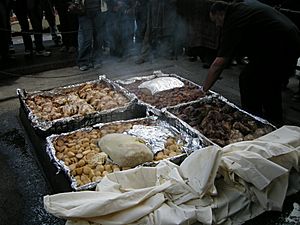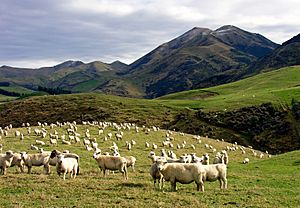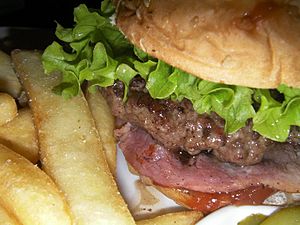New Zealand cuisine facts for kids
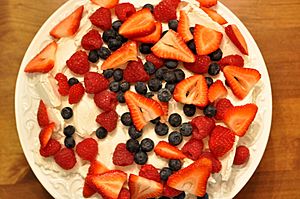
A pavlova, a popular dessert in Australia and New Zealand
|
|
| Country or region | New Zealand |
|---|---|
| National dishes | Fish and chips, meat pie |
| National drinks | Beer, coffee, lemonade, wine |
| See also | Beer in New Zealand, list of restaurants in New Zealand, Māori cuisine, pub food, wine in New Zealand |
New Zealand's food is special because it uses lots of fresh, local ingredients. Since it's an island country, it gets amazing food from both the land and the sea. Like Australia, New Zealand's cooking styles started with British traditions.
Over time, it has mixed with flavors from the Mediterranean and Pacific Rim countries. This happened as New Zealand became more connected to the world. Since the 1970s, new foods from places like America and Asia have also become very popular.
Contents
Māori Food Traditions

The Māori word for food is kai. When the Māori first arrived in New Zealand, they brought many food plants. These included kūmara (sweet potato), taro, and purple yam. Most of these plants grew best in the warmer north of the North Island.
Kūmara could grow further south and became a very important food. It could be stored for the winter. Native New Zealand plants, like fernroot, also became a big part of their diet. They also ate insects, such as the huhu grub, and earthworms called noke.
There were plenty of birds and sea creatures to eat. The large, flightless moa bird was hunted until it disappeared. Māori used rāhui, which are rules to protect resources. These rules stopped hunting certain animals in specific places or times. This helped keep animal populations healthy.
Seafood included freshwater crayfish (kōura), abalone (pāua), and bluff oysters (tio).
How Māori Cooked Food
Like other Polynesian people, Māori cooked food in earth ovens. In New Zealand, these are called hāngī, or sometimes umu. Stones are heated by fire in a pit. Food wrapped in leaves is placed on top of the hot stones.
Then, the food is covered with more leaves, cloth, or wet sacks. Finally, a layer of earth covers everything. This traps the heat and steam, cooking the food slowly. Other cooking methods included roasting, boiling, or steaming food using hot water from geothermal areas. They also cooked over open fires.
Some foods were kept fresh by smoking, air-drying, or fermenting them. They also preserved foods, especially muttonbirds, in layers of fat. The Māori people traditionally did not have any alcoholic drinks.
Food and Māori Beliefs
In traditional Māori religion, food was considered noa, meaning it was not sacred. It was important to keep food away from tapu (sacred) places or objects. If food touched something tapu, it could make that sacred thing lose its special power.
High chiefs and people doing sacred work, like tattooing, were tapu. They had rules about how they could handle food. The most tapu people even needed others to feed them. There's a story about a war party that had to wait because no non-tapu people were there to load their food.
European Food Arrives
When Europeans, called Pākehā, came to New Zealand, they brought their own foods. Some of these, like pork and potatoes, were quickly adopted by Māori. Potatoes were very popular because they grew easily and gave a lot of food.
Other European foods like wheat, pumpkin, mutton, and sugar also became part of the Māori diet. They were traded a lot with visiting ships. American sailors brought new types of kūmara that grew even better. Today, most kūmara are commercial types like Owairaka Red.
The arrival of maize (corn) led to a dish called kōpiro. This involves fermenting corn cobs in running water. Then, the kernels are scraped off and made into cakes to roast or steam. A European merchant named David Strang invented instant coffee in Invercargill in 1890. This drink quickly became popular in New Zealand and around the world.
Alcohol, which Māori first called wai piro (stinking water), also became accepted. Many Māori tribes grew extra food to trade. This trade made some tribes wealthy. However, the Māori food industry slowed down later due to land loss and competition. Many traditional foods, like the kererū (wood pigeon), became rare as forests were cut down.
Māori Food Today
Today, Māori food is a mix of old traditions, English cooking, and modern dishes. Some Māori food names, like pāua (a type of abalone), are now common in New Zealand English.
Most big Māori gatherings feature a Hāngī. This meal often includes foods brought by both Māori and Pākehā. In recent years, there has been concern about Māori health. This is partly due to changes in eating habits.
Two unique Māori dishes are the boil up and pork with pūhā (sow thistle). The boil up is made with pork, potatoes, kūmara, and dumplings. These dishes mix traditional and introduced foods. They also show the influence of 19th-century British cooking.
Another special food is rēwena or "Māori bread." It is made with fermented potatoes. A cookbook called Hiakai (2020) by chef Monique Fiso shares the history of modern Māori food. A dish called parāoa parai (fry bread) is served at special feasts. It is crispy outside and fluffy inside.
New Zealand European Food
Most New Zealanders are Pākehā, meaning they have British ancestors. So, British cuisine has had a very big impact on their food.
Early Settler Food
In the 1800s, British settlers in New Zealand tried to cook the same foods as back home. At first, this was hard because many ingredients were not available. Pākehā settlers ate native birds and fish. They used local ingredients instead of what they couldn't find. For example, they made tea and beer from unusual plants.
Most of these new ideas stopped as more Pākehā arrived. Regular ingredients were then imported or grown in New Zealand. One special dish, colonial goose, was popular until the 1980s. It was a stuffed leg of lamb cooked to taste like goose.
A big difference from Britain was that meat was much easier to get in New Zealand. In 19th-century Britain, workers ate very little meat. But in New Zealand, they could have it for every meal. Since meat was a fancy food in Britain, settlers in New Zealand ate a lot of it.
Like the British, Pākehā have always loved sweet foods. Many baking recipes are used for special events. These include cakes, scones, and muffins. The country's most famous recipe book, the Edmonds Cookery Book, started as an ad for baking powder. It has many baking recipes.
From British to Global Flavors
For most of the 1900s, New Zealand food was very similar to British food. New Zealand did not have big food shortages during World War II. However, meat and butter were rationed from 1943 to 1950. This was to help US forces and exports to Britain.
From the 1960s, cheaper air travel allowed New Zealanders to travel more. Many went to Europe and tried French and Italian cooking. They also found Indian and Chinese restaurants in Britain. When they came home, they wanted better and more varied food. They also started to appreciate New Zealand's own fresh produce.
In 1973, the United Kingdom joined the European Economic Community. This meant New Zealand's role as a food supplier to Britain changed. Cultural ties, including food, started to become less strong. During this time, some European dishes, like beef bourguignon, became common in New Zealand cooking.
The 1970s also saw big changes in takeaway food. The first American fast-food chains arrived: Kentucky Fried Chicken in 1971, Pizza Hut in 1974, and McDonald's in 1976.
The 1980s brought big economic changes. Farm subsidies were removed, making farmers find new ways to make money. Many started making special cheeses like Havarti and Brie. Some grew olives or grapes instead of traditional farming. Avocado oil for cooking was first sold in New Zealand in 1999.
These changes also made it easier to import special foods. Things like Spanish ham, Italian extra virgin olive oil, and Thai mangos became available. This led to many new and exciting food products in New Zealand.
The 1980s also saw a more open mind towards different cooking styles. New Zealand had developed its own culture, different from Britain. This made foreign foods more accepted. People with money felt free to enjoy fancy eating habits. It was like "being let out after a long school detention," as one expert said.
Other Cuisines in New Zealand
People from many different countries have moved to New Zealand. Many tried to cook their traditional foods. Like the early Pākehā settlers, this was often hard. Larger groups, like the Chinese, could import some ingredients. But often, dishes had to be changed to use local foods.
Ethnic restaurants became places for communities to meet. They also let other New Zealanders try new foods. For a long time, there were few ethnic restaurants. Most were Chinese, Indian, or Italian, and not always very authentic.
After 1986, immigration rules changed. More people came from East, Southeast, and South Asia. Many of these immigrants brought their cooking styles. They opened ethnic restaurants and takeaway places. This gave New Zealanders a chance to try real Japanese, Thai, Malay, and other Asian cuisines.
Over time, these foods became popular with Pākehā and Māori New Zealanders. Now, most New Zealand cities have many different ethnic restaurants. Foods like kebabs, couscous, and sushi are found almost everywhere. Many foreign dishes, like sushi and butter chicken, are now cooked at home and in regular New Zealand restaurants.
Ingredients for many ethnic dishes are now easy to find. You can buy them in special food stores or even in regular supermarkets. This has led to more authentic ethnic cooking. Some foreign ingredients, like extra virgin olive oil and sun-dried tomatoes, are now common. Even fish sauce and rice paper are no longer seen as exotic.
Modern New Zealand Food
Today, New Zealand's food scene is always changing. Modern Pacific Rim cooking is common in cities. Traditional settler food, sometimes called 'Kiwiana', is also popular. It is often updated with Pacific Rim cooking ideas.
In Auckland, home cooking mixes traditional Kiwiana dishes with Mediterranean and Asian styles. In more traditional areas, like rural Canterbury, old Kiwiana food is still very common at home.
Some traditional Kiwiana dishes are still loved everywhere. These include fish and chips, meat pies, custard squares, and pavlova. There's a movement to keep traditional Kiwiana food alive. TV shows like Kiwi Kitchen help with this. Many people feel that traditional dishes are disappearing. Home baking is seen as the last place where New Zealand food is not changed by global trends.
Food habits are also changing in Australia. They are moving towards lighter foods influenced by Mediterranean and Southeast Asian styles. New Zealand and Australia share a lot of history and culture. So, New Zealand chefs and diners often follow trends from Australia. Many chefs have worked in Australia and bring ideas back home.
Generally, New Zealand and Australia have similar food tastes. New Zealand food trends often follow Australia's by a few years. For example, Mediterranean cooking became popular in New Zealand in the 1990s, but in Australia in the 1980s. However, in cities like Auckland and Wellington, food trends are now very similar to Sydney and Melbourne.
A big change has been the rise of café culture. Traditional tearooms have mostly disappeared. Before the 1990s, tearooms offered cream tea, cakes, and cucumber sandwiches. They served filtered coffee or tea. New Zealanders copied the Mediterranean idea of drinking espresso-based coffees. They also invented instant coffee, which is now used worldwide.
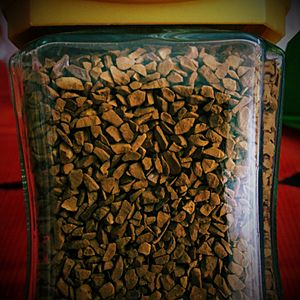
Cafes became popular, and many tearooms changed into cafes. Cream tea is no longer fashionable in New Zealand restaurants. Scones are now mostly baked at home.
Vegetarianism used to be seen as an unusual lifestyle. But it became more common in the 1980s. The Ministry of Health encourages people to eat less meat. However, New Zealanders still eat a lot of meat. They eat less red meat now, but more fish and chicken because they are cheaper. In 2019, people ate about 75.2 kg of meat per person. This included chicken, pork, beef, and lamb.
New Zealand Food Around the World
New Zealand food doesn't have a huge impact globally. But Australia does feel some influences from New Zealand. The famous dessert, the pavlova, has caused a long argument with Australia about where it was invented.
Fusion cuisine and foreign cooking styles mix with modern New Zealand food. New Zealand chefs learn from global trends. Chefs like Peter Gordon and bakers like Dean Brettschneider influence fusion foods. Cuisine magazine, started in 1986, is well-known among food lovers worldwide.
How New Zealanders Eat
Most New Zealanders eat their main meal, called 'dinner' or 'tea', in the evening. This change from midday dinners started in the early 1900s. But Sunday midday dinners were common until the 1960s. By 1982, most families ate their main meal in the evening.
In summer, barbecues are very popular social events. Guests usually bring beer or wine, and sometimes meat for the host to cook. Guests might also bring a salad. Traditionally, men cook the meat. Many gardens have special areas for barbecuing.
Similar Māori gatherings often feature a hāngī. This is a pit where meats or fish are cooked with vegetables. A deep hole is dug and lined with hot stones. It is then covered with plants. Food is placed on top and covered with damp cloth or leaves. Water is added, and the hole is quickly covered with earth. The food then steams for several hours. Traditionally, men dig the hole, and women prepare the food. Everyone in the extended family (whānau) helps with such a feast.
Many New Zealand gatherings have a custom called 'bring a plate'. Each guest brings a plate of food to share. This helps hosts entertain large groups without spending too much. Guests might also bring salads or meat to a barbecue. Most New Zealand parties are 'BYO' (bring your own alcohol). However, the drinks are usually not shared.
New Zealand's dining-out culture grew a lot in the 1960s. This was partly due to changes in alcohol laws and the popularity of cafés. People often visit cafés for lunch or snacks. Eating at a restaurant is still seen as a special treat for most people.
Fish and chips is a very popular takeaway meal in New Zealand. Since the 1970s, a bigger fast food culture has grown, like in the United States. Many American fast-food chains are in New Zealand. Local ones, like Burger Fuel and Hell Pizza, have also started.
The meat pie is like New Zealand's street food. You can buy them in dairies, bakeries, supermarkets, and petrol stations. Pies are usually filled with beef, lamb, chicken, or vegetables. Sweet pies are less common. A fast-food chain based on pies, Georgie Pie, started in 1977. It closed in 1998, but pies were sold through McDonald's restaurants from 2013 to 2020.
In malls, food courts have become popular. Auckland alone has several. Immigration has brought more choices and better quality. Many food courts offer Asian cuisines like Thai, Indian, Turkish, Malaysian, Japanese, and Chinese. They also offer New Zealand foods like roast dinners.
Popular New Zealand Foods
Foods Created in New Zealand
- Hāngī (earth oven cooking)
- Pavlova (meringue dessert)
- Colonial goose (stuffed lamb)
- Cheese roll (cheese on bread, rolled)
- Lolly cake (biscuit cake with lollies)
- Kānga pirau (fermented corn)
- Rēwena bread (Māori fermented potato bread)
- Boil up (pork, potato, kūmara stew)
- Paraoa parai (Māori fry bread)
- Toroī (mussel and kūmara dish)
- Hokey pokey ice cream (vanilla with honeycomb pieces)
- Afghan biscuits (chocolate biscuit with cornflakes)
- Anzac biscuits (oat and coconut biscuit)
- Seafood fritters (often with whitebait, mussel or pāua)
- Marmite (New Zealand variety) (salty spread)
- Kiwi onion dip (onion soup mix dip)
- Fairy bread (bread with sprinkles)
- Pineapple lumps (chocolate-covered pineapple candy)
Imported Foods, Now Important in New Zealand
- Fish and chips
- Roast lamb and mutton
- Vegemite (salty spread)
- Scones
- Lamingtons (sponge cake with chocolate and coconut)
- Sausage sizzle (sausage in bread)
- Savoury pies (meat, fish or bacon and egg)
- Sausage rolls
- Pikelets (small pancakes)
- Shortbread
Images for kids
See also
 In Spanish: Gastronomía de Nueva Zelanda para niños
In Spanish: Gastronomía de Nueva Zelanda para niños
- List of Australian and New Zealand dishes
- Category:Restaurants in New Zealand
- List of Oceanian cuisines


